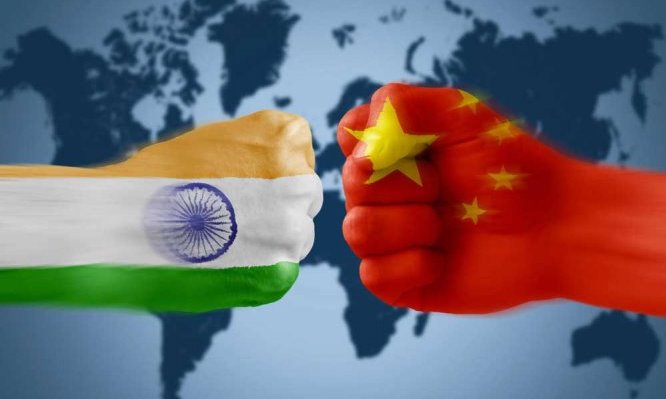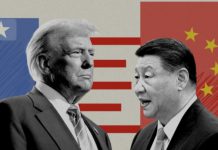The China-India relationship is remarkably stable in many ways with bilateral summits and new multilateral groupings often bring the two Asian heavyweights together in many causes – yet some important differences and suspicious is still persist with rapidly changing Geo-strategic and Geo-political vulnerabilities.
Before the 1960s both countries were in spiraling romanticism chanted Hindo-China brotherhood in the streets of New Delhi & Beijing both states where considered as converted darlings. Indo-China border which stretches from the north along with the Himalayan region became bone of contention between two mighty neighbors. Tensions flare on a fairly regular basis between the two regional powers over their 3,500-kilometre frontier, which has never been properly demarcated yet.
Both countries fought a short but decisive war in 1962 when China ruined Indian Borders troops with superior firepower. There are over a dozen places in the Ladakh area, near the Bhutan-China border, and in Arunachal Pradesh where the two countries differ over the on-ground position of the LAC. The 2017 Doklam dispute, in the central sector, was one such dispute. The current crisis has seen as the assertive claimant’s over some strategic Areas. India blames China for its illicit escalation & China says Indian military construction across LAC is the sole reason for current skirmishes. At least 20 Indian soldiers died after clashes with Chinese troops at the Galwan Valley in Eastern Ladakh.
The simultaneous face off at three different places along the LAC appears not only well-coordinated but also part of a plan that could not have been conceived at the local or sub-area level. The intensity of confrontation is not only confined to LAC but there are series of disputed areas along the China-India border, like Doklam, Sikkim, Ladakh, Arunachal Pradesh, and some the Tibetan Plateau, a very important strategic piece of land. Of course, the border is really the Tibetan-Indian border—and that is precisely why China has always wanted to control it.
This is the geopolitics of fear. If China did not control Tibet, it would always be possible that India might attempt to do so. Three of China’s great rivers, the Yellow, Yangtze, and Mekong, starting from the Tibetan region which is why Tibet is known as “China’s Water Tower.”.
Another location often mentioned as a potential birthplace for the next Dalai Lama is Tawang in Arunachal Pradesh, home to an important Buddhist monastery. That territory is held by India but claimed by China as “Southern Tibet,” making it a top potential flashpoint for protests and the spillover of a China-India crisis. Dalai Lama is the major irritating for China, China doesn’t want to see any public uprising, revolt, purposeful protest Against Mainland China. Indian specious support to the Buddhist monks & Dalai Lama always put China in a fire and furry reaction toward New Delhi.
The growing trust deficit between two nuclear-armed neighbours would escalate the situation to a certain degree of miscalculation. border clash could inflict dozens of casualties, jolt global markets, hurt regional economic growth, and undermine cooperative China-India efforts on regional and global issues of concern to the United States, including counterterrorism and counterpiracy, even if both sides managed to avoid a more serious military escalation.
The current bloody military confrontation along LAC would be resolved under Civil-Military leadership if the belligerent parties tended to any meaningful willingness. It may be resolved with diplomatic efforts, the future of India-China peace, in the Chinese view, depends on India’s ability to pursue its China policy independently and not under the shadow of the growing U.S.-India alliance. To China’s, Indian tendency toward Washington is Purley designed against China’s encirclement & covert Containment of Chines influence in the region. China will hold an incendiary policy against India if both countries interest clashes on the ground.
Both countries first time after the deadliest war in 1962, went to a direct face -to face fight which takes precious lives of the twenty Indian soldiers.
With changing Geo- political Geo- strategic landscape current China-India border clash is considered the ongoing Global Geopolitical gameplay in the region. China a first hard-hit country from the Covid-19 would want to divert public attention from the additional cost caused by the unseen enemy Covid-19. China also wants to divert masses attention from the internal fastidious sentiments to an external enemy. China’s communist party always hold similar fear in case of public anger mass protest it would endanger its credibility and justification as a single ruling Party for the long term. Indian Bharatiya Janata party has played the same rhetoric against Pakistan in its concurrent victories in 2014 and 2019 general Election.
The Himalayan quagmire.
Himalayan mountains contain similar security advantages as Golan heights for Syria and Israel. Control over these tantalizing Peaks would give upper Hand against another. A keen parity can be seen in Siachin glaciers between Pakistan and India.
China shares thousands of Kilometre thorny borders With India which simultaneously considered as a natural wall from both sides. There are series of highest mountains, passes, Peaks, clumsy glaciers and narrow belts along China-India border. In case of the military standoff, it would be difficult to conquer each other from the highest mountaineering region, where tanks, howitzers mobilization, troops deployment, access to heavy artillery, food supply chain moments of the fighting forces is always been a difficult task to avert. This will also lead both countries to use their most sophisticated weapons from both sides which would tend to direct nuclear clash. The long-range missile, fighter jets would trigger both neighbours to the brink of full-pledge military confrontation.
China has a “qualitative edge” over India in terms of nuclear weapons and delivery means. However, it noted that China has an upper hand over India in terms of military might, especially since Nepal and Sri Lanka, “once-reliable India allies, have “titled” towards China. India shares the same animosity with Nepal over the “Kala Pani” region claimed by Nepal as its integral part. India also shares territorial antagonism with Bangladesh especially on water resources.
Tit-for-tat appointment
In case of further escalation China and India would seek diplomatic and economic means of retaliation to hurt each other interests, China will halt its massive investment in India and trade coercion while India will use its membership support to Shangai Cooperation organization, Asia infrastructure development bank’ and Brazil, Russia, India, China South Africa (BRICS )alliance. Meanwhile, India has a dubious stance over China’s massive economic project BRI -Belt and Road initiative. It would be a catastrophic curse to bilateral ties if they have taken the same escalating measures.
Pakistan factor
Current India-China border clash is broadly linked with five August move from India parliament, abrogation of article” 370″ which badly concerned China assertion over Some claimant’ regions along India China border, near the politically sensitive areas of Kashmir and Tibet. Chinese fighters were making sorties within 30 km of their side of the LAC. The abrogation of article 370 equally irritates China-Pakistan growing concerns over Azad-Kashmir and Gilgit Baltistan. Chines massive economic project CPEC -China Pakistan economic corridor is passing through these strategically important regions, India can break Pakistan-China strategic assets from the LAC Ladakh region a short way to Gilgit Baltistan and Azad-Kashmir. Chinese anger hints its large reservation over China’s Pakistan economic corridor. This time China will respond with extremely punitive measures to thwart Indian aims for any military objectives crafted by GHQ and Lok Sabha. India would not plunge to two fronts- confrontation at once time. During China-India war 1962 Pakistan lost a decisive opportunity to annex Indian occupied Kashmir, this time India would be more cautious to avoid two-front confrontations.
Implications for US interest
An armed confrontation between China and India would put the United States in a no-win position. Beijing would likely perceive any U.S. support to India as part of an unwelcome US strategy to contain China. That would contribute to a sharpening of global competition between China and the United States in ways Washington would prefer to avoid, or at least to postpone despite US military alertness in the South China Sea and its notorious Indo- Pacific strategy US would not wish to see both neighbours on the brink of a direct military clash.
China and India have lucrative trade markets with huge purchasing Powers including two billion population. Chinese and Indian economies could potentially harm U.S. investors, retailers, manufacturers, and service providers.
Heightened Maritime competition between China & India
Both countries have never been involved in direct Naval intimidation but they share escalating vulnerabilities in the region, India Free navigation policy in the South China sea, and suggestion to resolve South China sea diplomatically, while India has no direct clash with India Navy in Pacific and Indian oceans. India support to Vietnamese coastal areas oil drilling and bilateral Naval exercises. India’s rise as a regional and international power and a counterweight to China. Quadrilateral military alliance with the US, Australia, Japan which potentially designed against China’s growing maritime assertiveness in the region. China is gradually but smartly building its blue -Water Navy to get access to the international water bodies, China’s interest in Bangladeshi important Seaport Chittagong, Sri Lanka Hambantota which China leased for the next 99 Year and the most important Pakistan deep Seaport Gawadar. US wants to build formidable green water Indian Navy to help US strategic interest as a reliable partner, it is the “irritant” factor in the Chinese security apparatus. China responding to India with reciprocating measures, China is going to sell sophisticated Naval warships, Submarines, and other equipment to Pakistan as a strategic competitor Against India.
Condition a portion of US military assistance to India
In the case of military Assistance to India, the US would not take a potential risk to lose Pakistan as an important ally against War on terror and reliable partner in US Taliban Peace talks. US military assistance will surely Defuse Islamabad, Washington ties which further endanger US long term goals in the region. It will trigger Sino-Us ties which both countries would not want to bear.it may ignite China-US confrontation in the South China region. The US would go for mitigating the option to bring both neighbours on the table talk. The US knows China’s military superiority Over India, 1962 situation may Harm US long term policy against China as a first-line strategic competitor.
Maintain and expand the US military presence in the Indo-Pacific
China-US confrontation in Indo- Pacific region, the South China Sea, and the Indian ocean would escalate both countries deteriorating relations, US military presence, and its expanding War machinery would cause China-US direct military clash, which both countries will avoid at any cost. Taiwan issue is already hanging on the heads of US-China Civil-military leadership. The United States incessant support to Taiwan government which China,s claims as its internal part, would be a potential reason for the military standoff between two world heavyweights.
The world is already in trouble fighting with unidentified enemy Covid-19. China-US military confrontation on the behest of India would batter the international economy which is already in shaky condition.
Preventive options
Both countries, rising military and economic powers may opt for mitigating policy to thwart any military misadventure. There will be massive human casualties, and materialistic losses if war trigger between two nuclear weapons states, both countries enjoying huge trade partnership and organizational alliance for better Asian rise, curtailed policy from both sides would sink their economic goals in the Indian ocean.
Conclusion.
Wars always bring immense catastrophes, it brings starvation, disease, and ashes to the succeeding generation, China and India have more than two billion population in case of nuclear war millions of people can embrace the fatal consequences of twenty-first-century technological firepower .it will harm the global economy and maritime trade, oil supply, tourism, and most important Global environmental impacts. There are millions of reasons to fight and billion of reasons to cooperate, mitigate bilateral mistrust, and politically designed antagonism. Pakistan China and India are the potential nuclear weapons states it may push the third country to the flame of fire. You can change your fate destiny but you can’t change your neighbor, now it’s the need of hours to think sensibly and to avert any military miscalculation for the better future of Rising Asai.
Qaiser Mahmood: Undergraduate student of international relations, International Islamic University Islamabad. The views and opinions in this article belong to the author and do not necessarily reflect the editorial policy of Millat Times.

















